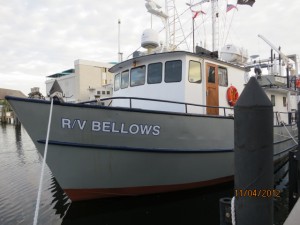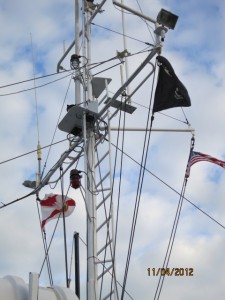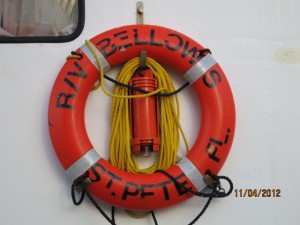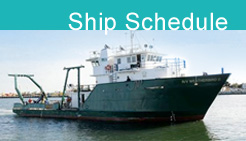Deep Sea Fish and Sediment Surveys in the Gulf
Welcome aboard the R/V Bellows!
Take One: November 5, 2012
C-IMAGE Teacher at Sea, Eileen Hayes
Our crew and science personnel gathered at Bayboro Harbor on the USF campus
this morning to begin our C-IMAGE expedition! Our mission: monitor water
quality and plankton communities along two transects off of Florida’s west
continental shelf and assess the impact of the BP Deep Water Horizon oil spill
on the Gulf’s ecosystems. Departure was at 08:00.
Our safety briefing included important information such as always wear PDF’s (personal flotation devices) and closed-toe shoes while on deck and don’t go out on deck alone at night!
Chief scientist for the cruise is Dr. Kendra Daly. For further information about her Zooplankton Ecology Lab, please visit www.marine.usf/zooplankton/. Science personnel onboard include four scientists from the College of Marine Science/USF: Leslie Schwierzke-Wade – Chief Biological Scientist, Karen Dreger – Research Engineering Technician and SIPPER operator, Jonelle Basso – Marine Microbiology Lab Technician, and Teresa Greely – Ocean Biologist and Educator; Tim Lee, a USF graduate student; Sharien El-Tourky – Zooplankton Ecologist and graduate assistant at RSMAS/University of Miami; and two C-IMAGE Teachers at Sea – Abby Madeiros and Eileen Hayes.
After water samples were collected at the first station, Leslie, Jonelle and
Tim started to filter and analyze the samples while Abby and Eileen observed
the process before participating. In the interim, Karen deployed the SIPPER using
the winch off of the back of the Bellows and Sharien conducted plankton tows
off the port side of the ship. After observing her collection under the
microscope, she found that she was successful in capturing her targeted zooplankton
Farranula gracilis. The entire process had settled into a well-run routine.
As the afternoon progressed, the seas started to get a little rough and water
samples sloshed around the lab more and more. Only two CTD stations were
sampled, and the SIPPER had been difficult to deploy. Rougher seas were
predicted because of a low pressure system to the north, and it appeared
unlikely that we could complete the Southern transect stations without
returning in harsh seas. The captain and scientists decided it would be best to
turn around and reschedule the expedition early the following week when calmer
seas were anticipated. We arrived back at Bayboro Harbor about 4 a.m. – not
even a full 24 hours later. Such is life at sea!
| Print article | This entry was posted by greely on November 14, 2012 at 8:51 am, and is filed under Oceanic Updates. Follow any responses to this post through RSS 2.0. You can leave a response or trackback from your own site. |






